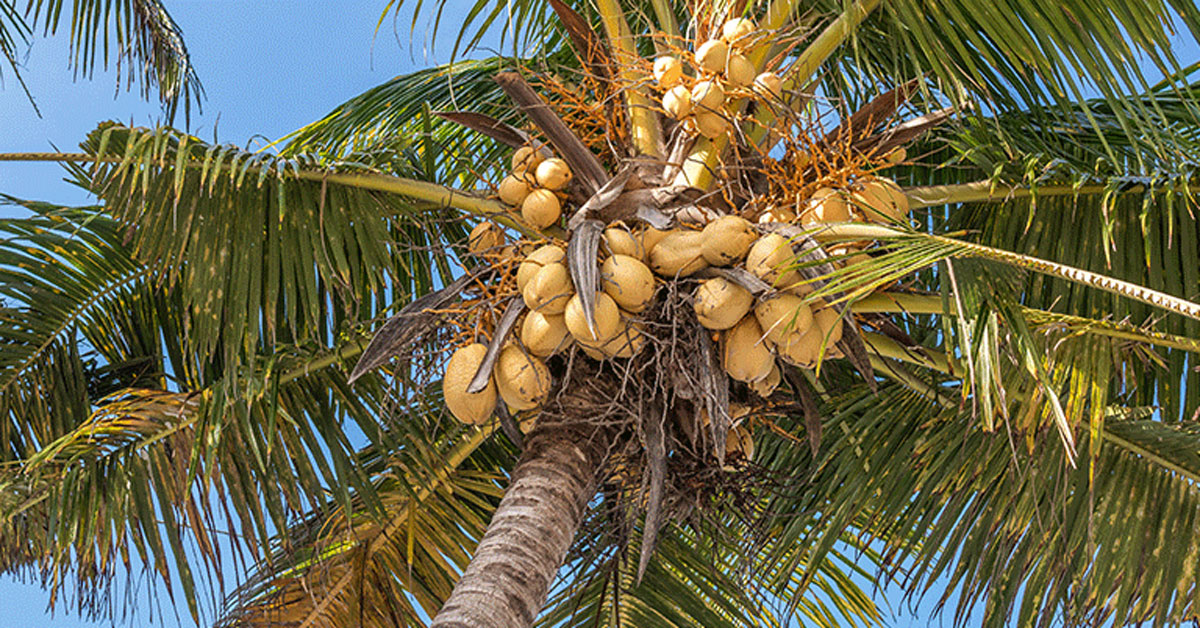Coconut shavings, coconut oil, coconut flour, coconut cream, coconut milk – what is it that coconut can’t do? If you love coconut products, you might be tempted to plant a coconut palm tree of your very own. Hey, I get it! Let’s talk about how to plant a coconut palm tree of your very own.
Before you get too excited, it’s important to keep in mind that coconut palm trees are a tropical tree. If you live in a cooler climate, your tree won’t ever be planted outdoors. Coconut palms can only grow in USDA plant hardiness zones 10, 11, and 12. These zones are pretty much found only in California, Arizona, Texas, Alabama, and Florida.
Coconut palm tree growers in Texas and Arizona in particular may experience difficulties with keeping their coconuts property watered. Coconuts are tropical trees, which means they need lots of heat, water, and humidity. Extremely arid climates may not suit coconut palms, even if the temperature is right.
Fast facts about coconut trees
Some quick, important things you should know about coconut trees:
- USDA Hardiness Zone: 10-12
- Tree height: 20-100 feet
- Pollination: Self pollinating
- Yield: 75 fruit per year
- Lifespan: 100 years
- First fruit: 6-10 years
How to plant a coconut tree
So the time has come to plant your coconut tree. Great! We’ve got a gameplan for where it will eventually go and now it’s time to get the tree started. First, you’re going to need a fresh coconut that still has its very outer husk.
Selecting a healthy, live coconut is vital as well. A good coconut will have water inside of it. You can shake the coconut and hear the water sloshing around inside of it.
To germinate the coconut, first soak it in room temperature water over 70 degrees for three days. Once it’s finished soaking, you can plant it in a pot filled with standard potting soil with a bit of sand mixed in. Choose a large pot at least one foot deep.
Don’t fully cover your coconut seed with soil. Plant it on its side with the pointed end oriented downward and one-third of the coconut seed above the soil. The first shoot of coconut growth will come off of the pointed side, so this part must be under the soil.
Keeping your coconut in a warm spot is important for the germination process. The warmer you can make it, the better. Don’t allow temperatures to drop below 70 degrees Fahrenheit.
Be sure to water your coconut seed often during the germination phase. Be sure the pot can drain, though. Your coconut needs moist soil but not soggy. Well draining soil and a container with proper drainage holes is important for this part of the growing process.
And now…you wait! This is the boring part. It will take 3-6 months for your coconut to germinate and begin growing.
Read More: 5 Reasons Why Cities Should Plant Urban Fruit Trees
Caring for coconut trees
Now the interesting part! Your coconut has sent up a little green shoot of growth and we’re off to the races. Now you need to care for your coconut tree!
Coconuts truthfully aren’t very challenging to maintain once they’ve sprouted, but like all trees, they do need specific care. Be sure you’re keeping the air temperature no cooler than 70 degrees Fahrenheit and you’re continuing to keep your soil damp.
If your tree needs to be repotted, repeat the soil mix that you did before. Mix in a little bit of sand into potting soil.
Your coconut tree will need to be fed as it grows – it is a nutrient demanding plant. In particular, it needs a standard fertilizer that contains boron, manganese, and magnesium.
What to do if you live somewhere cold
Here’s the sad thing: if you’re reading this from Chicago, New York, Portland, or just about anywhere but the very southern, hottest parts of the US, your coconut tree can’t ever go outside. You can, however, plant it in a pot. But there’s a catch.
Potted coconut trees don’t tend to grow to full size, produce coconuts, or last all that long. A potted coconut tree usually gives up and dies after about 5 years. But that doesn’t mean it isn’t still a pretty fun process planting and growing your own coconut! And who knows, if you really like it, maybe a move to South Florida is in your future?
Want to try a few other trees?




